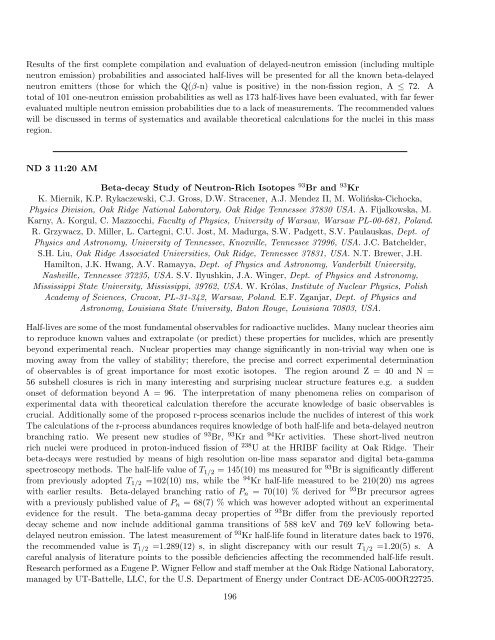Program - Brookhaven National Laboratory
Program - Brookhaven National Laboratory
Program - Brookhaven National Laboratory
Create successful ePaper yourself
Turn your PDF publications into a flip-book with our unique Google optimized e-Paper software.
Results of the first complete compilation and evaluation of delayed-neutron emission (including multiple<br />
neutron emission) probabilities and associated half-lives will be presented for all the known beta-delayed<br />
neutron emitters (those for which the Q(β-n) value is positive) in the non-fission region, A ≤ 72. A<br />
total of 101 one-neutron emission probabilities as well as 173 half-lives have been evaluated, with far fewer<br />
evaluated multiple neutron emission probabilities due to a lack of measurements. The recommended values<br />
will be discussed in terms of systematics and available theoretical calculations for the nuclei in this mass<br />
region.<br />
ND 3 11:20 AM<br />
Beta-decay Study of Neutron-Rich Isotopes 93 Br and 93 Kr<br />
K. Miernik, K.P. Rykaczewski, C.J. Gross, D.W. Stracener, A.J. Mendez II, M. Wolińska-Cichocka,<br />
Physics Division, Oak Ridge <strong>National</strong> <strong>Laboratory</strong>, Oak Ridge Tennessee 37830 USA. A. Fijalkowska, M.<br />
Karny, A. Korgul, C. Mazzocchi, Faculty of Physics, University of Warsaw, Warsaw PL-00-681, Poland.<br />
R. Grzywacz, D. Miller, L. Cartegni, C.U. Jost, M. Madurga, S.W. Padgett, S.V. Paulauskas, Dept. of<br />
Physics and Astronomy, University of Tennessee, Knoxville, Tennessee 37996, USA. J.C. Batchelder,<br />
S.H. Liu, Oak Ridge Associated Universities, Oak Ridge, Tennessee 37831, USA. N.T. Brewer, J.H.<br />
Hamilton, J.K. Hwang, A.V. Ramayya, Dept. of Physics and Astronomy, Vanderbilt University,<br />
Nashville, Tennessee 37235, USA. S.V. Ilyushkin, J.A. Winger, Dept. of Physics and Astronomy,<br />
Mississippi State University, Mississippi, 39762, USA. W. Królas, Institute of Nuclear Physics, Polish<br />
Academy of Sciences, Cracow, PL-31-342, Warsaw, Poland. E.F. Zganjar, Dept. of Physics and<br />
Astronomy, Louisiana State University, Baton Rouge, Louisiana 70803, USA.<br />
Half-lives are some of the most fundamental observables for radioactive nuclides. Many nuclear theories aim<br />
to reproduce known values and extrapolate (or predict) these properties for nuclides, which are presently<br />
beyond experimental reach. Nuclear properties may change significantly in non-trivial way when one is<br />
moving away from the valley of stability; therefore, the precise and correct experimental determination<br />
of observables is of great importance for most exotic isotopes. The region around Z = 40 and N =<br />
56 subshell closures is rich in many interesting and surprising nuclear structure features e.g. a sudden<br />
onset of deformation beyond A = 96. The interpretation of many phenomena relies on comparison of<br />
experimental data with theoretical calculation therefore the accurate knowledge of basic observables is<br />
crucial. Additionally some of the proposed r-process scenarios include the nuclides of interest of this work<br />
The calculations of the r-process abundances requires knowledge of both half-life and beta-delayed neutron<br />
branching ratio. We present new studies of 93 Br, 93 Kr and 94 Kr activities. These short-lived neutron<br />
rich nuclei were produced in proton-induced fission of 238 U at the HRIBF facility at Oak Ridge. Their<br />
beta-decays were restudied by means of high resolution on-line mass separator and digital beta-gamma<br />
spectroscopy methods. The half-life value of T 1/2 = 145(10) ms measured for 93 Br is significantly different<br />
from previously adopted T 1/2 =102(10) ms, while the 94 Kr half-life measured to be 210(20) ms agrees<br />
with earlier results. Beta-delayed branching ratio of Pn = 70(10) % derived for 93 Br precursor agrees<br />
with a previously published value of Pn = 68(7) % which was however adopted without an experimental<br />
evidence for the result. The beta-gamma decay properties of 93 Br differ from the previously reported<br />
decay scheme and now include additional gamma transitions of 588 keV and 769 keV following betadelayed<br />
neutron emission. The latest measurement of 93 Kr half-life found in literature dates back to 1976,<br />
the recommended value is T 1/2 =1.289(12) s, in slight discrepancy with our result T 1/2 =1.20(5) s. A<br />
careful analysis of literature points to the possible deficiencies affecting the recommended half-life result.<br />
Research performed as a Eugene P. Wigner Fellow and staff member at the Oak Ridge <strong>National</strong> <strong>Laboratory</strong>,<br />
managed by UT-Battelle, LLC, for the U.S. Department of Energy under Contract DE-AC05-00OR22725.<br />
196
















